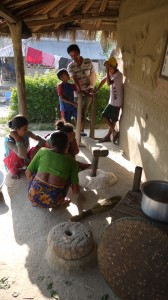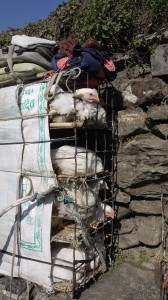Looking at Our Initiatives From the Other Side of the World

People gathered around the communal grain mill turning rice into flour. The process demands three hours of manual labor.
They say you can’t go home again, but, in my experience, you truly can never leave home behind.
I love going far, far away on vacation. I want to experience a different culture, eat food I can’t get in the United States, and be surprised by things I’ve never even imagined. Yet, I often find myself thinking about Bon Appétit Management Company.
This year I went trekking in the Himalayas of Nepal. Here are a few of the things I witnessed and how the experience sometimes turned my views on our sustainability commitments on their side.
The Himalayan people are subsistence farmers. It’s truly remarkable how much they can grow on a terraced hillside without gas-powered equipment, synthetic fertilizers, or pesticides. I saw rice, potatoes, cabbage, onions, carrots, mustard greens, peas, beans, okra, and several kinds of grains as well as goats, chickens, and buffaloes. Still, food is precious. They make up for the lack of abundance with a lot of spice, which adds to the feeling of satiety. The staple of their diet is dahl bat (lentils and rice), but everywhere we stopped also had their own version of momos (dumplings) filled with whatever was coming out of the fields that day. My personal favorite was the mustard greens, which gave an unexpected punch of flavor.
As soon as I learned that most egg-laying hens spend their entire lives in a cage less than the size of a piece of paper, I went to work on crafting a cage-free egg policy for Bon Appétit. My commitment to providing more space for hens hasn’t wavered since seeing these chickens in Nepal, but the experience did make me think about how ethno-centric our policies can be.
There are no roads leading to the mountain villages we visited, so everything is transported on pony trains. This is a slow process and without the ability to refrigerate meat, chickens are brought in live. As you can see in this photo, the conditions are even more cramped than in conventional battery-cage egg production. Yes, the practice is cruel. I even saw one cage with a live chicken smashed up against another that had not survived the stressful journey.
However, I couldn’t wrap my head around telling these impoverished, hungry villagers that they needed to bring less protein up the mountain or decrease the efficiency of their limited transportation options in any way. Are high animal welfare standards a luxury of wealthier countries?
On the flip side, once the chickens make it to their destination, they lead pretty good lives. They are certainly all free-range. I spent about 10 minutes watching a hen and a rooster dust-bathing. I realized I have written hundreds of marketing pieces saying that hens in barren battery cages are not able to perform natural behaviors such as nesting and dust-bathing (sound familiar?), but I had never actually seen the joys of dust-bathing. Seems I had to go halfway around the world to witness what we promote in our cafés every day.
